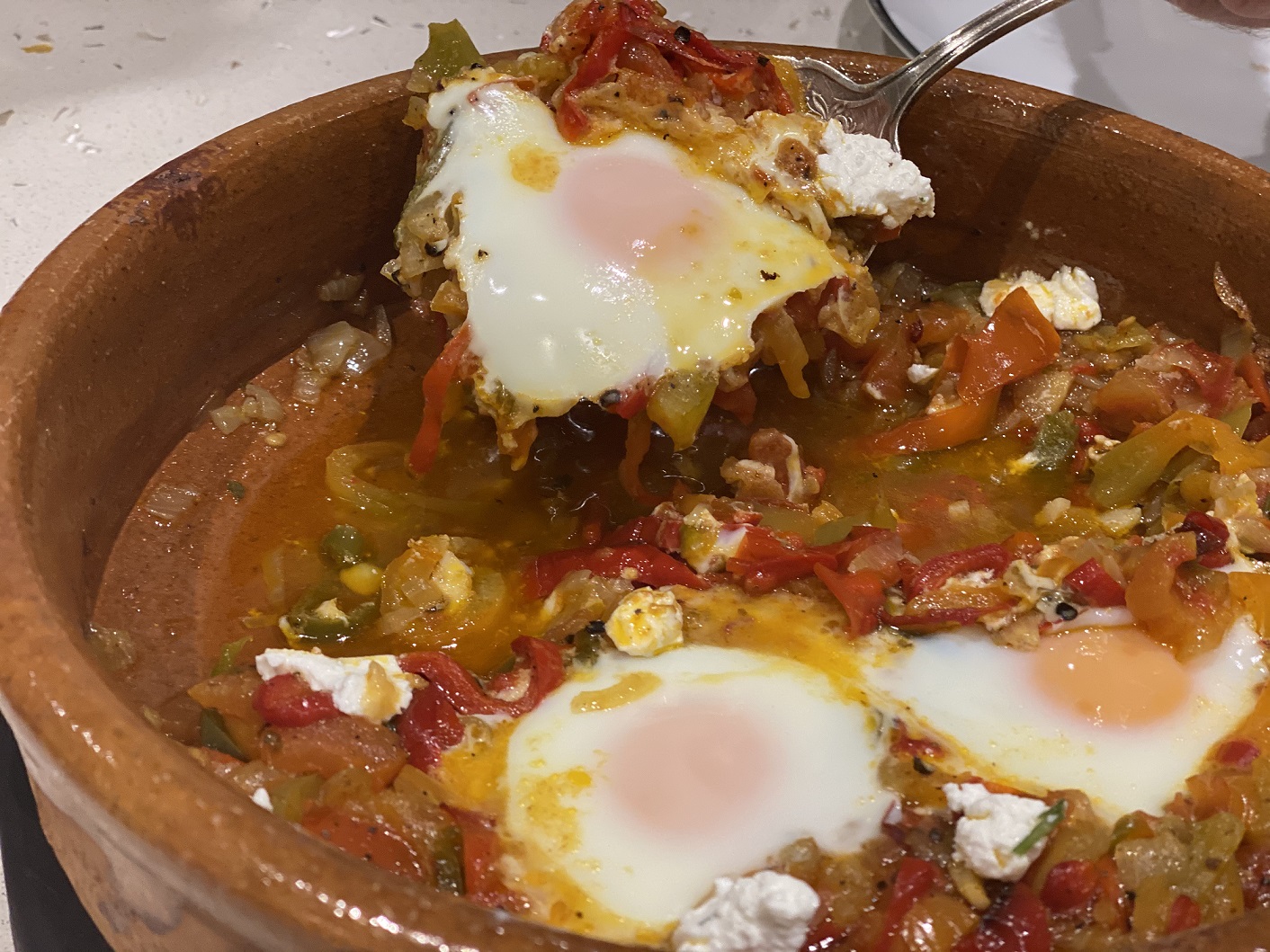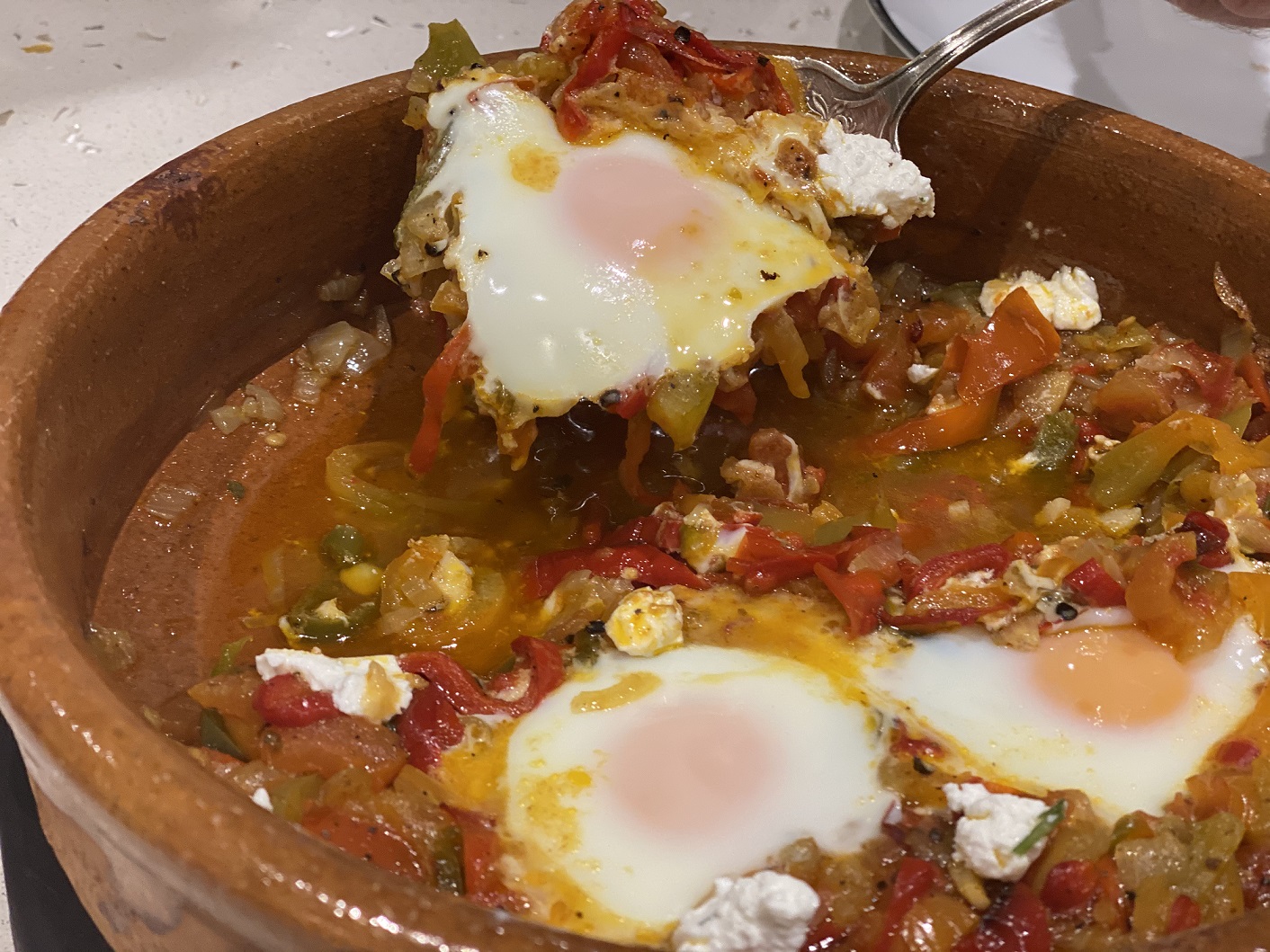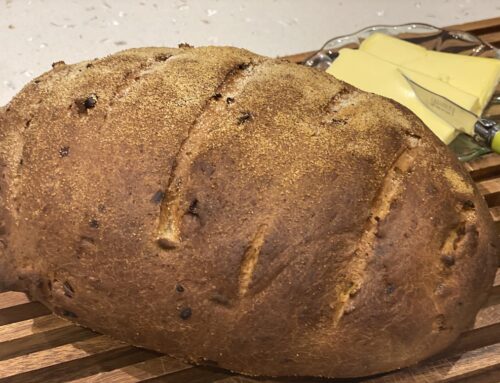Pipérade from the Basque* country is made with green or red peppers and pimentos, onions, tomatoes and garlic, slowly cooked together, with beaten egg added at the end and slowly stirred through to cook the eggs; it is usually served with slices of the famous and delicious Jambon de Bayonne, which is similar to prosciutto. My pipérade varies slightly from the traditional in that I do not beat the eggs and stir them through to cook them as in scrambled eggs; rather I prefer to cook my eggs nestled into the ‘stew’ as in the photograph here. Bacon or ham added to the capsicums and tomatoes is also delicious.
This dish is marvellous on its own, especially as a breakfast or lunch dish; for a more substantial meal, serve it with a steak, chicken or with ham. You can even add
Serves
| Ingredients | |
| 30ml extra virgin olive oil 30g butter 2 medium onions, thinly sliced 2 medium sized red capsicums, deseeded, thinly sliced 2 medium sized green capsicums, deseeded, thinly sliced 2 medium sized yellow capsicums, deseeded, thinly sliced If the yellow are expensive, substitute with red and / or green capsicums 4 tomatoes, roughly chopped |
3 – 4 garlic, peeled and diced 1tsp oregano 1tsp marjoram ½ fresh chilli or ½ tsp dried chilli flakes Sea salt and freshly cracked pepper 4 eggs Garnish Soft curd goats’ cheese Finely chopped parsley |
Preheat the oven to 180℃.
There is no need to be rigid with these ingredients. Substitute the capsicum colours and herbs to suit availability and your preferences. It is a simple, colourful country dish.
Pour the extra virgin olive oil into a pan, add the butter and onions and cook gently, for 10 minutes, until well softened and they start to turn yellow.
Cut the capsicums on half lengthwise and remove the seeds and white membranes. Slice into strips, about ½ cm wide, no more, add them to the pan and cook, occasionally stirring, for about 15 minutes before adding your roughly chopped tomatoes.
Add the finely chopped garlic, oregano and marjoram, chilli and cook until the tomatoes are nearly a pulp. Season with sea salt and ground black pepper. Spoon into the ovenproof serving dish.
Make 4 indentations in the top of the capsicum and tomato ‘stew’; crack an egg into a small jug and carefully slide the egg into the hole. Repeat with all the eggs. Carefully place in the hot oven and cook for 10 minutes until the white is cooked and the yolks are still runny.
Serve immediately, garnished with the goat’s cheese scattered over the top with the finely chopped parsley.
*Pipérade I ate in Provence was a variation of Elizabeth David’s classic, being more like a capsicum, tomato, galric and onion warm salad. This memorable day was some years ago, during the Picnic in Provence culinary week, when we enjoyed a sensational Picnic in the Vineyard, overlooking Sablet, a beautiful tiny Provençal village. The day was still, sunny and warm with the beautiful Provençal blue sky above. We were driven to a special, secret place, nestled up high in the vineyard with a good view over Sablet. A long, linen covered table had been set up for us and we lunched on various local dishes with wines from the vineyard.
The pipérade for that lunch, was made with roasted red capsicum, skinned and sliced into thin strips. Roasted, ‘collapsed’ tomatoes which were roughly chopped. These were mixed with minced garlic and fresh thyme. A drizzle of extra virgin olive oil, a pinch of fleur de sel from the Camargue and freshly ground black pepper. There were no eggs.
Other Mediterranean countries have similar dishes. In Italy, their dish of roasted capsicums and tomatoes is called Peperonata; it is called the shakshuka in the Middle East and the Berber omelette in Morocco.
I love my version of the Pipérade, which is based on the recipe of Elizabeth David’s which appeared in two of her books, French country cooking and in her French Provincial Cooking.
Pipérade, when made according to Elizabeth David’s recipe, does not include the multicoloured array of peppers which I had included in my pipérade; I love their colour and flavours, so I include them. When you cook this, cook what you please with what is available in the markets.
- Ingredients
- The cooking
- Adding the eggs
- Serving – delcious!












